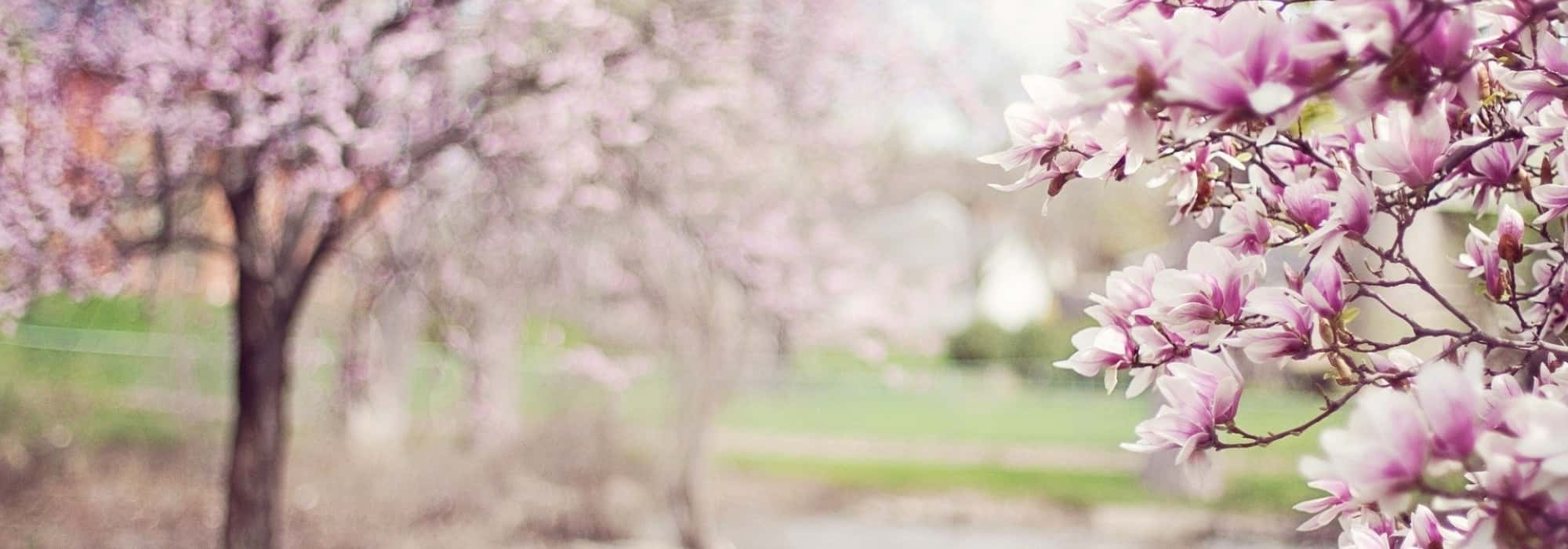
The most beautiful specimen trees
Which tree to choose based on your garden?
Contents
The solitary tree is one of the centrepieces of the garden. Whether its foliage is weeping, evergreen, or deciduous, it adds character, volume, and shade during the beautiful season. To successfully integrate a beautiful ornamental tree, you must first step back to make the right choice. Its aesthetics, habit, but especially its size at maturity are determining criteria based on the land you have available. Here is our selection of the most beautiful decorative trees for your garden.
Which tree to choose for a small garden?
In a small garden, it is advisable to choose trees with low growth, reaching heights of 2 to 3 m. Some varieties can also be grown in pots.
- The magnolia, with its abundant spring flowering in the shape of a tulip and its ramified habit, is a beautiful decorative tree ideal for small gardens. Its resistance to pollution makes it very suitable for urban areas. Hardy down to -20 °C, it acclimatises to almost all our regions, except for the Mediterranean coast. Magnolias prefer a sunny or semi-shaded position, in cool, humus-bearing soil. Choose a compact variety, such as Magnolia brooklynensis ‘Eva Maria’, which will reach 1.50 m in all directions, the magnolia ‘Black Tulip’, slightly taller, with its purple flowers, or the Magnolia stellata ‘Rosea’ (Star Magnolia), known for its numerous light pink, fragrant star-shaped flowers. They can also be grown in pots.
→ Learn more about Magnolias in our complete guide.
- The Ginkgo biloba ‘Mariken’, does not exceed 2.5 m in all directions and has a decorative habit, both compact and globose. Its originality comes from its fan-shaped leaves. Its deciduous foliage is light green in summer, then takes on beautiful golden hues in autumn. Very hardy and resistant down to -30 °C, it acclimatises almost everywhere, but it dislikes drought and excessive moisture. It thrives in full sun, in any good deep, fertile, and well-drained soil.
→ Learn more about Ginkgos in our complete guide.
- Small varieties of Japanese maple, not exceeding 3 m in height, such as Acer palmatum ‘Katsuras’, bring charm and originality to small urban gardens that are semi-shaded to shaded. They prefer slightly acidic, well-drained soil. They are also suitable for pot cultivation. The main advantage of Acers lies in their spectacular foliage, more or less dissected and changing colours throughout the seasons, as seen in Acer palmatum ‘Red Pygmy’, or Acer palmatum ‘Orange Dream’.
- The Cercis canadensis ‘Lavender Twist’, also known as “Weeping Lavender Twist Redbud“, is a tree that reaches up to 3.5 m in height and has a very weeping habit. In spring, its very decorative twisted branches are covered with a beautiful cascade of pink flowers. Hardy and easy to grow, it thrives in a small garden or even in a large pot in the sun, as long as its soil remains cool. Its deciduous foliage, green in summer, takes on stunning golden colours in autumn.
→ Learn more about Cercis in our complete guide.
- The Laburnum alpinum ‘Pendulum’, also known as ‘Alpine Laburnum’, is distinguished by its slightly weeping habit, particularly graceful. Easy to grow, it thrives in full sun or partial shade, in well-drained soil, even calcareous, poor, and fairly dry. Fast-growing, it will reach 2 m in spread in all directions, the ideal size for an ornamental tree in a small garden. Its beauty is enhanced by its bright and fragrant spring flowering of hanging yellow flowers in clusters.
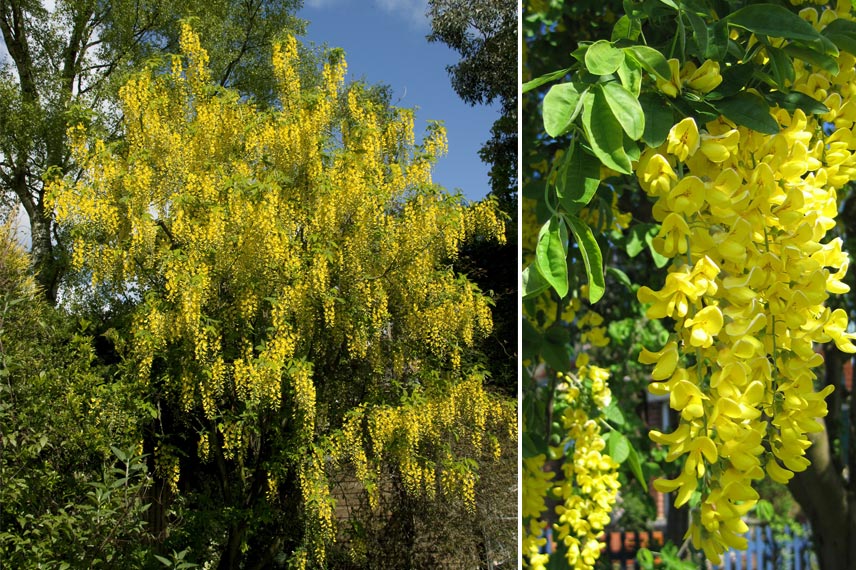
Laburnum (Laburnum cytisus)
→ Learn more about Laburnums in our complete guide, and in our article on weeping habit trees.
Read also
7 trees for an urban gardenWhich tree to choose for a medium-sized garden?
In a medium-sized garden, an ornamental tree can enhance a green corner, add character, a splash of colour, or simply provide a restful shaded area. It is easy to plant small to medium-sized trees. Here is our selection of decorative trees for a medium garden:
- The Robinia pseudoacacia ‘Umbraculifera’ (ball acacia) is very original due to its round and dense crown atop its straight trunk. At maturity, it will reach 5.5 m in height with a spread of 4 m. Its resistance to pollution makes it a tree perfectly suited for urban environments. Its late foliage, a beautiful green, turns yellow in autumn before also falling late. This variety is devoid of flowering. Easy to cultivate and hardy, it tolerates cool soil without excess and even dry conditions in summer once well established. It thrives in full sun, sheltered from strong winds and salt spray.
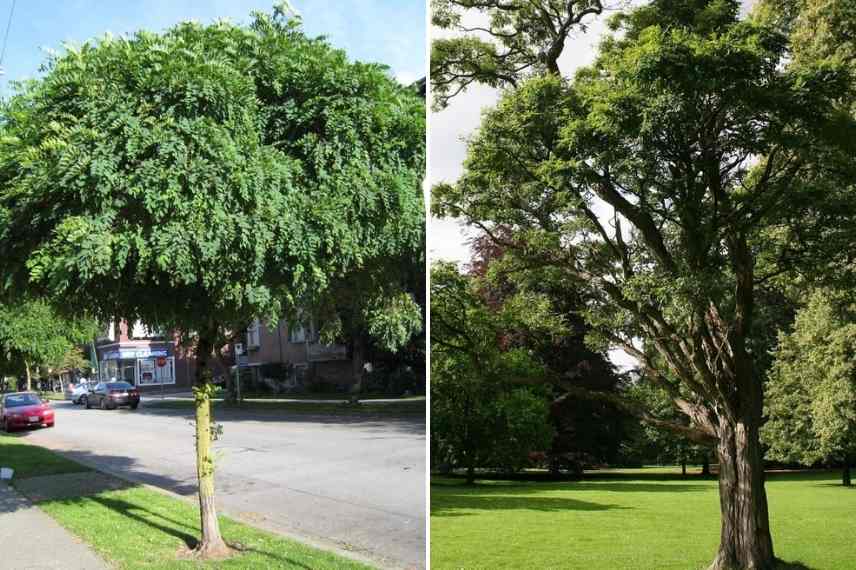
Robinia pseudoacacia ‘Umbraculifera’ (ball acacia)
- The Robinia pseudoacacia ‘Casque Rouge’, also known as “false acacia”, with its flowering in long pendulous clusters of purple-pink, is a very beautiful decorative tree when planted alone. At maturity, it measures 8 m in height with a spread of 4 m. Its habit is airy with green foliage in summer, turning golden in autumn. It is particularly ornamental and adds charm to a medium garden. Hardy, it easily adapts to all regions and tolerates all types of soil, even dry once established. If you have enough space, you can also consider the Robinia pseudoacacia, with white flowers, which will dominate the garden with its 15 m height.
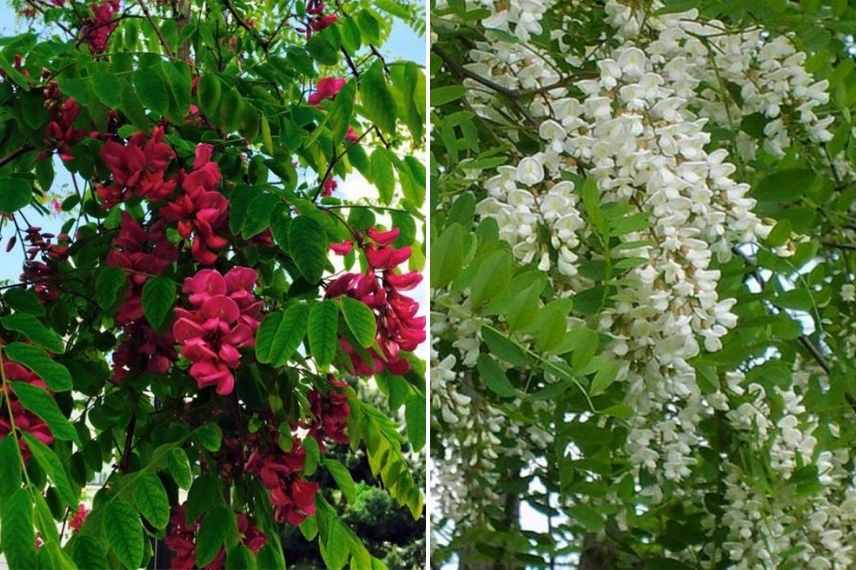
The flowers of Robinia pseudoacacia ‘Casque Rouge’ and Robinia pseudoacacia
- Albizia, also known as silk tree, is a graceful small tree with its deciduous foliage, very fine and finely cut, evoking the lightness of mimosa. With its spreading parasol habit of 5 m spread and 7 m height, it will provide light shade in a medium-sized garden. During the summer season, it boasts a wonderful flowering in silky pom-poms of pink, red, or white. Undemanding, drought-resistant, and easy to cultivate, it enjoys a sunny exposure in well-drained soil. It thrives in oceanic and Mediterranean regions but fears very cold areas. Its uniqueness: its deciduous foliage folds in on itself at night.
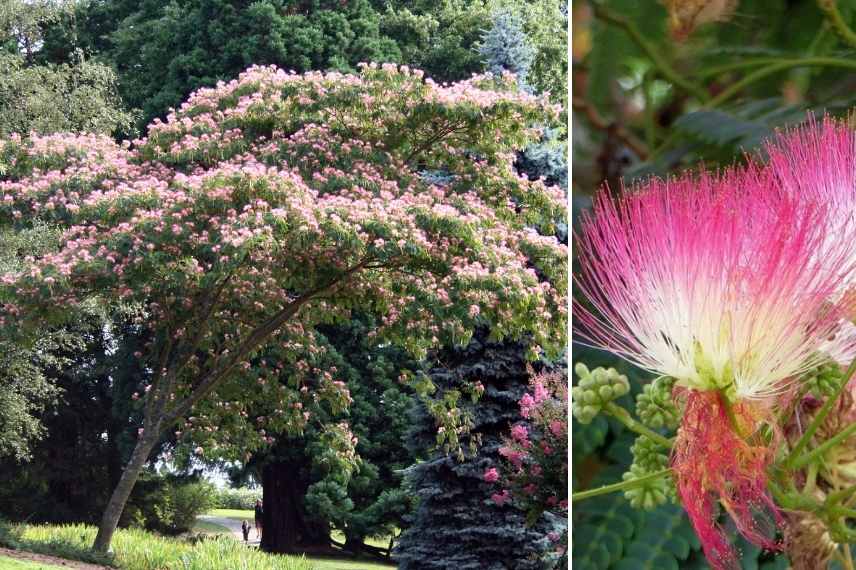
→ Learn more about Albizias in our complete guide
- Japanese flowering cherry or Prunus serrulata ‘Kanzan’ offers a magnificent and abundant spring flowering in pink tones. Perfect when planted alone, it towers over the garden with its 6 m spread and its upright habit. Its foliage, bronze at bud burst, green in summer, turns yellow-orange in autumn. Very hardy, it will adapt to all regions, even the coldest. However, it does not tolerate excessive dryness in Mediterranean areas. It thrives in full sun in light, well-drained soil.
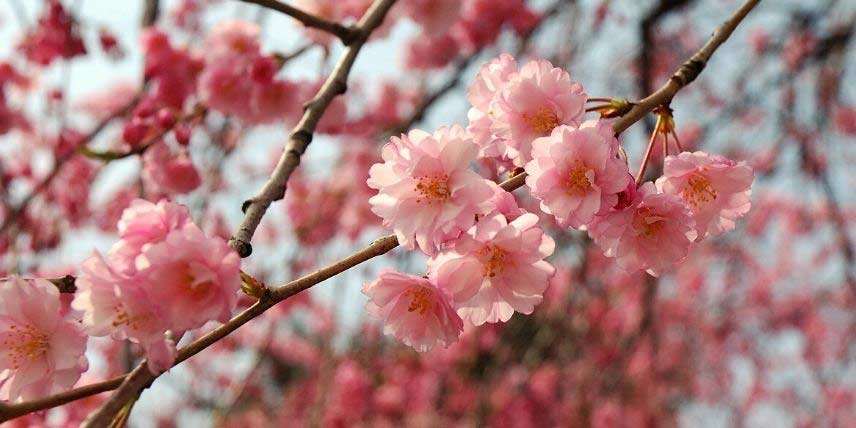
Flowers of the Japanese cherry
→ Learn more about ornamental Prunus in our complete guide
- Catalpa is a beautiful medium-sized ornamental tree, with a very spreading and dense habit, whose spread can reach 10 m in all directions. Perfect for shading a garden or terrace during the summer! Its deciduous foliage consists of large green leaves in Catalpa bignonioides, or golden yellow in Catalpa bignonioides ‘Aurea’, giving it a tropical appearance. Its beautiful white flowering in summer will form astonishing bean-shaped fruit pods. The Catalpa is a hardy tree with very rapid growth, suitable for full sun or partial shade, in cool, well-drained soil, under most of our climates.
Discover other Trees and large shrubs
View all →Available in 0 sizes
Available in 1 sizes
Available in 1 sizes
Available in 1 sizes
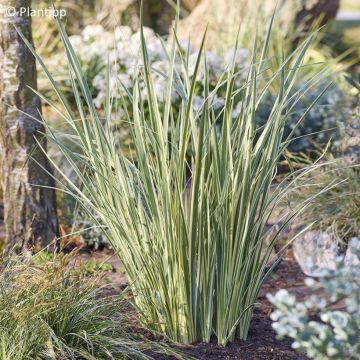
Available in 1 sizes
Available in 1 sizes
Available in 1 sizes
Available in 1 sizes
Available in 2 sizes
Available in 1 sizes
Which tree to choose for a large garden?
In a large garden, one can afford a bit of exuberance and think big! A sumptuous solitary tree adds volume, atmosphere, and a true personality to your park. Here is our selection of majestic trees:
- Weeping Willow (Salix alba ‘Tristis’), with its trailing branches reaching down to the ground like a curtain of greenery, is a must-have for large spaces. Its rapid growth allows it to reach 20 m in height and width. Its light green foliage turns yellow in autumn before falling, revealing its slightly twisted main branches. Hardy and easy to grow, it enjoys full sun in rich, deep, and even heavy, moist soil. It thrives near ponds, but care should be taken not to plant it too close to buildings.
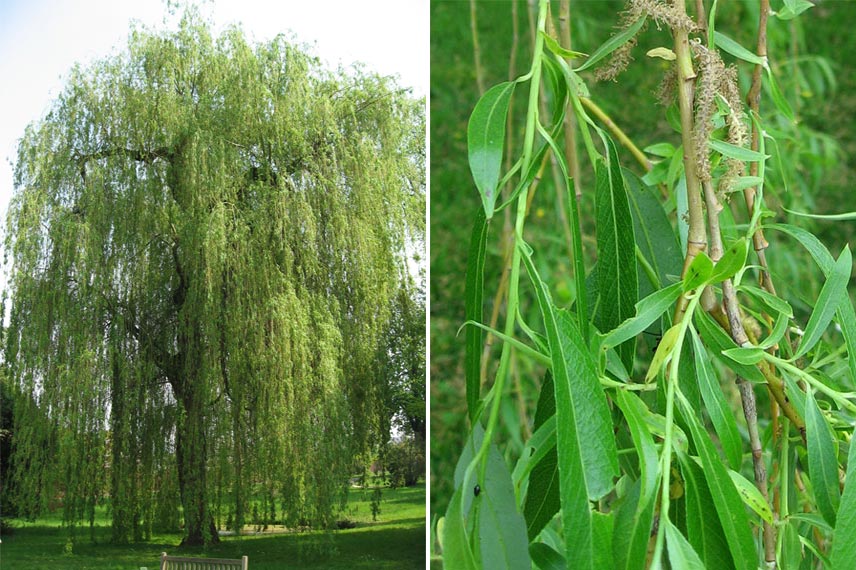
The long, flexible branches of the Weeping Willow (Salix alba ‘Tristis’) cascade down to the ground.
- The Davidia involucrata ‘Sonoma’, known as the handkerchief tree, offers a spectacular spring flowering in the form of clusters of stamens surrounded by large, durable white bracts. The deciduous foliage of this variety is a bright light green on top and a greyish, felted, and downy underside. Unique, the variety Davidia involucrata ‘Lady Sunshine’ stands out with its variegated leaves. Both trees can flower from a young age. The handkerchief tree prefers gentle sun and partial shade, sheltered from strong, cold winds, spring frosts, and excessive heat. It enjoys fertile, rich, fresh, well-drained soil and tolerates the presence of lime well. In our latitudes, it can reach up to 12 m in height and 10 m in spread.
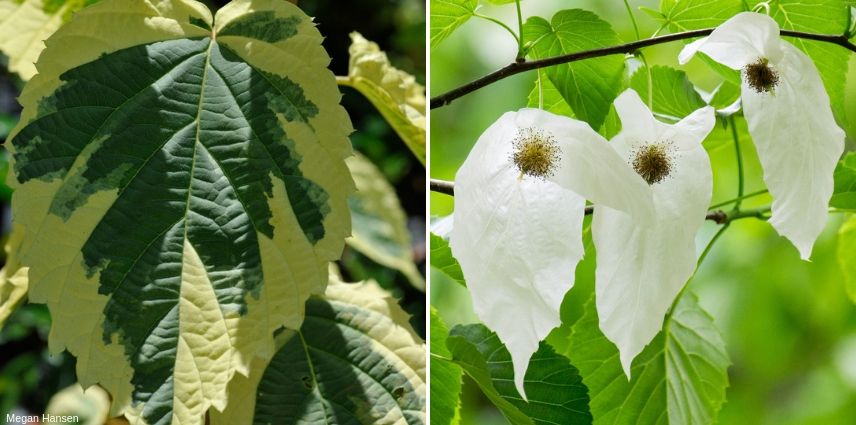
Variegated foliage of Davidia involucrata ‘Lady Sunshine’ and typical flowers of the handkerchief tree
→ Learn more about Davidias in our complete guide.
- The large-leaved lime (Tilia platyphyllos ‘Rubra’) is a very beautiful, remarkable tree reserved for large spaces. Its deciduous foliage, a lovely green, turns golden in autumn, revealing its young coral-red branches. In summer, it produces a melliferous and pleasantly fragrant flowering. Slow-growing, it reaches 15 m in height with a spread of 10 to 12 m. It enjoys full sun or partial shade, as well as ordinary but consistently moist soil.
→ Learn more about Limes in our complete guide.
- The umbrella pine, this sublime conifer with its iconic silhouette, looks magnificent in a large garden as a solitary specimen. Highly ornamental, it is also appreciated for its pine nuts. This beautiful conifer enjoys sun and warmth and can adapt as far north as the Paris region. Once established, it tolerates drought and sea spray perfectly. Low-maintenance, it adapts to all soil types, but young trees are sensitive to severe frosts in cold regions. The young Pinus pinea forms a green ball, then with age, it becomes immense, shedding its lower branches to take on a venerable appearance at a height of 20 m.
-
- The silver birch is a majestic tree that will naturally find its place in a large garden. Its brown bark cracks over time and turns white, making it very decorative as a solitary tree. With its rapid growth, it can reach up to 20 m in height. Its branches, initially upright then drooping, are covered with beautiful green foliage that rustles in the wind. In autumn, its leaves take on golden hues. Very cold-resistant, it acclimatises easily in all our regions but struggles with sea spray. The birch enjoys sunny or partially shaded exposures. Easy to grow, it tolerates all types of soil. This tree produces many shallow roots that can hinder the establishment of other plants, making it perfect as a solitary specimen.
→ Learn more about Birches in our complete guide.
Read also
10 trees to shade a small gardenTip
Feel free to take lovely walks in botanical gardens or parks to familiarise yourself with the pruning of trees. This will give you an idea of the space that certain varieties occupy once mature. And who knows, you might just come across the one of your dreams!
To go further:
- Find even more varieties of trees for small gardens here.
- Need shade in a large garden? Here’s our selection of 10 shade trees.
- Discover our article on weeping habit trees.
- All our tips for removing a tree stump.
- Check out our explanatory sheet on the different habits of trees.
- Subscribe!
- Contents
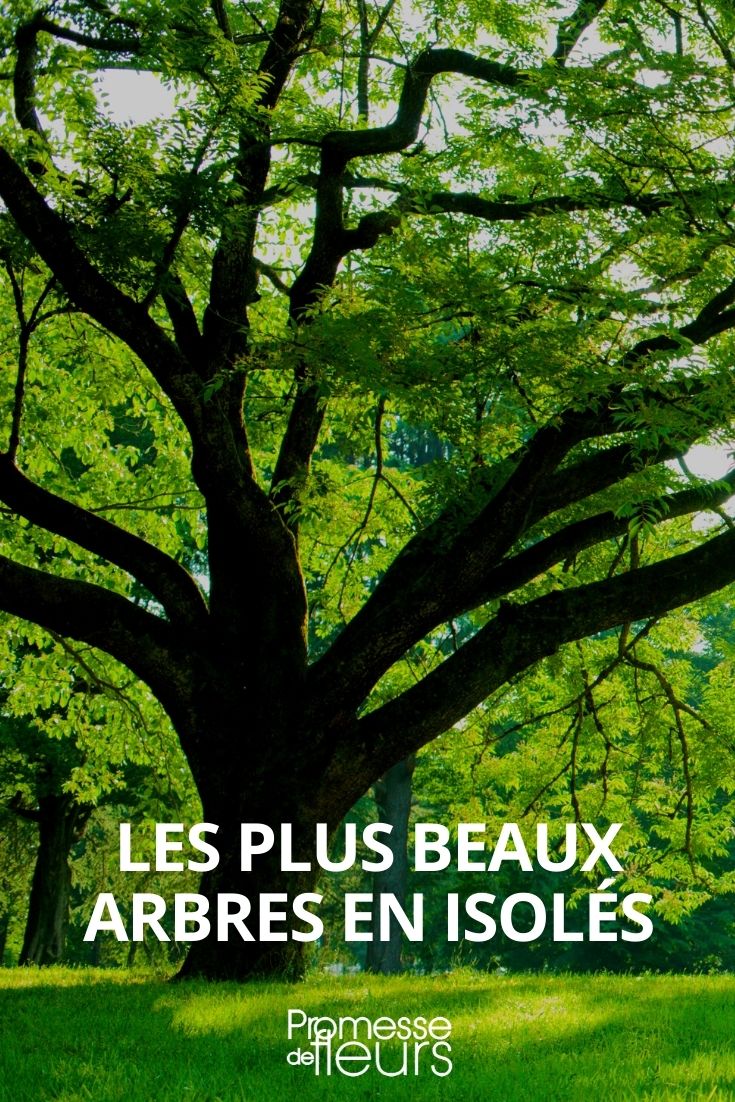































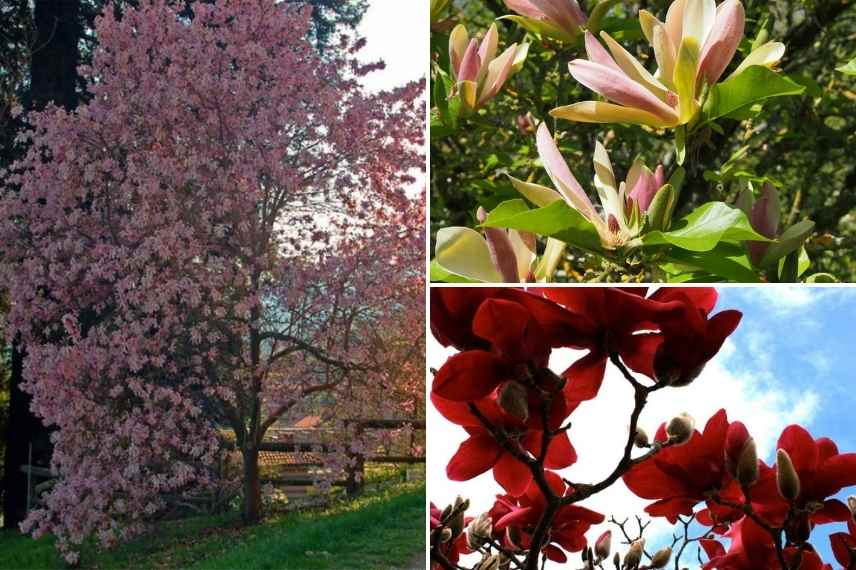
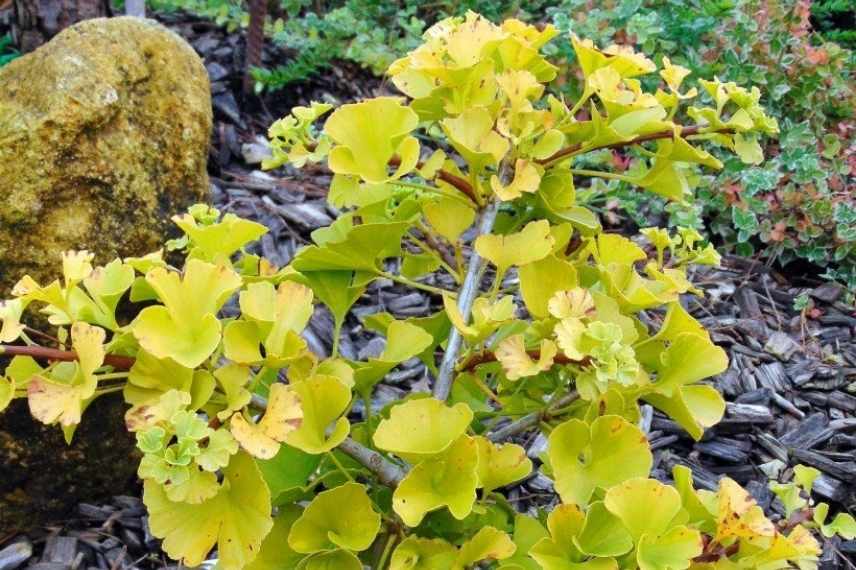
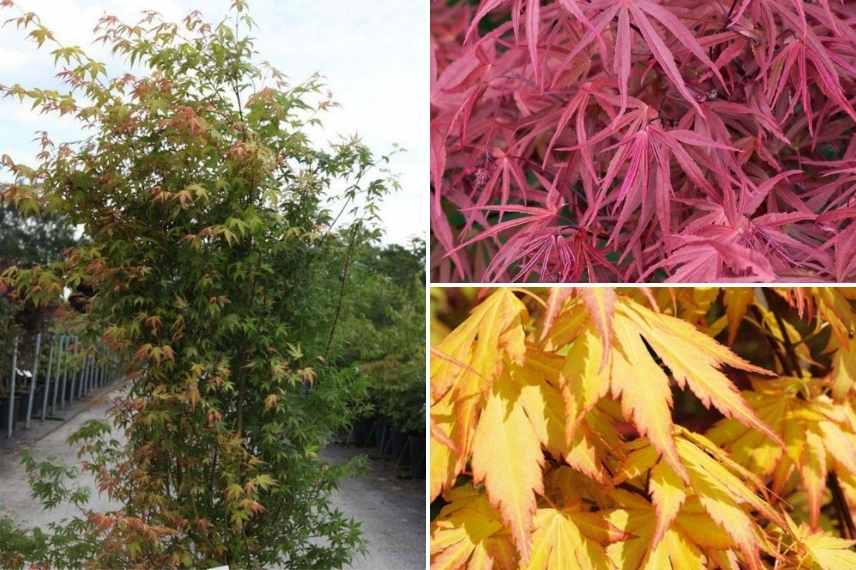
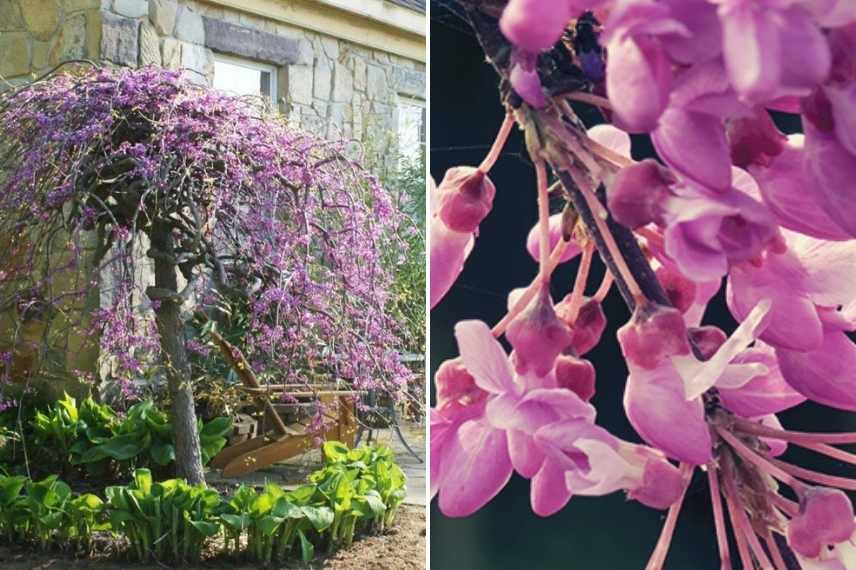
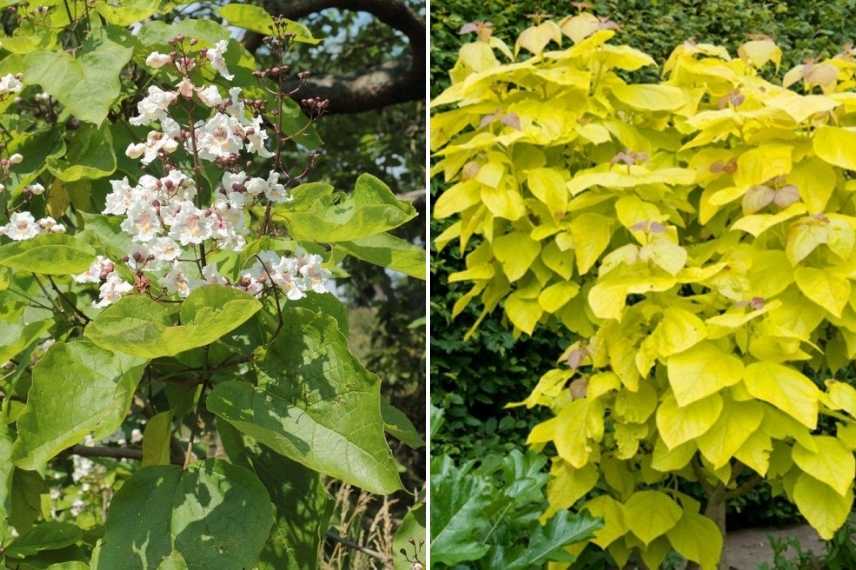

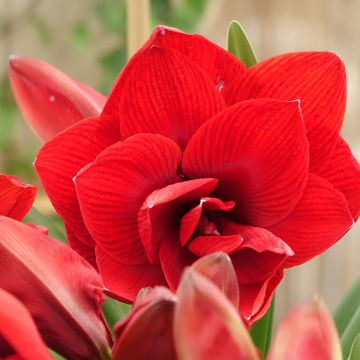


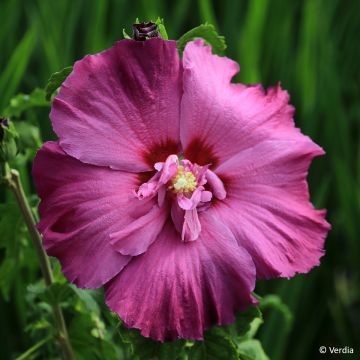
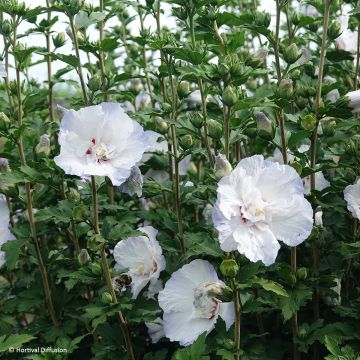
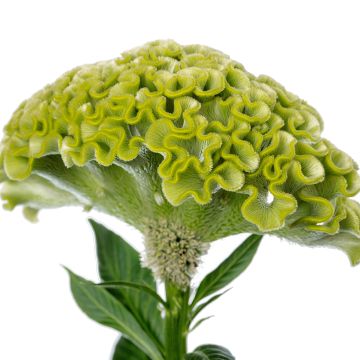
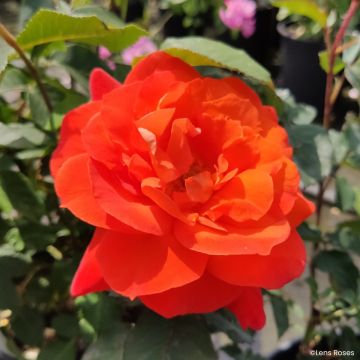
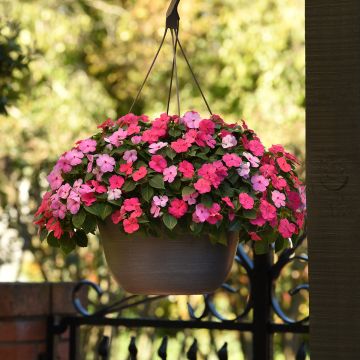
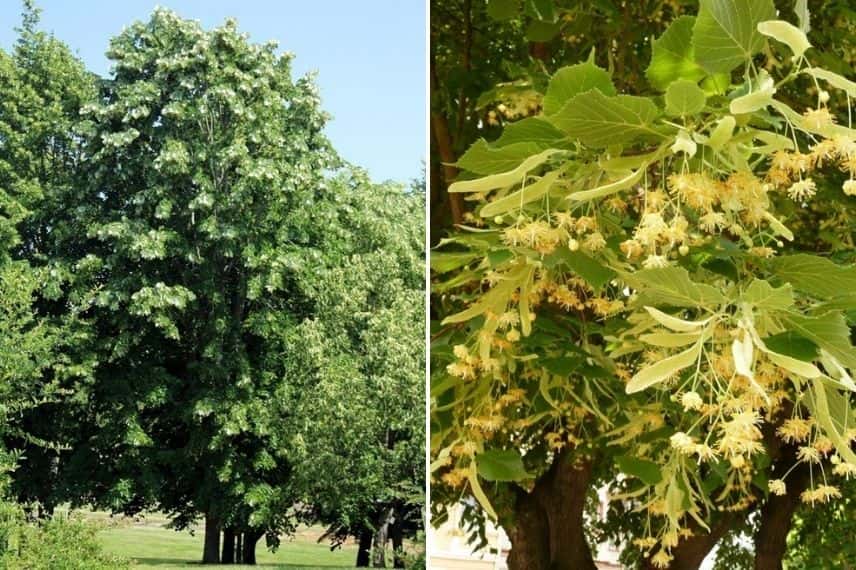
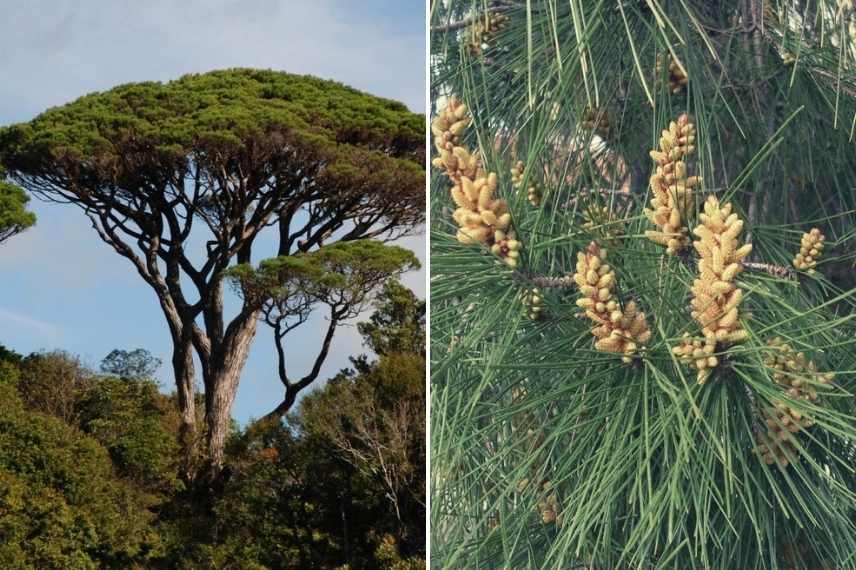
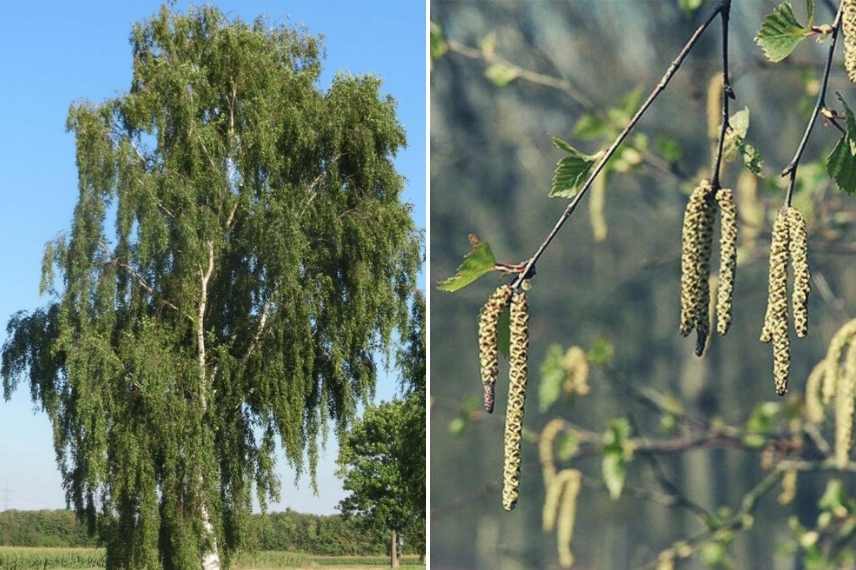
Comments